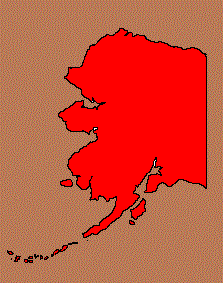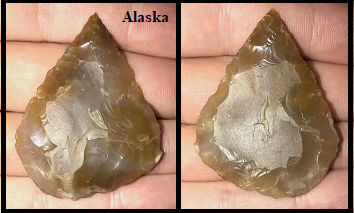Outline is Representative of Size and Shape:

Name Details:
Identified By: John P. Cook
Named For: Chindadn Complex
Date Identified: 1969
Type Site:
Identified By: John P. Cook
Named For: Chindadn Complex
Date Identified: 1969
Type Site:
Point Validity:
Valid type
Cook is a well published anthropologist who conducted extensive surveys and excavations through-out Alaska. This type was named in a professional publication and has many professional references. This is considered a valid type.
Cook is a well published anthropologist who conducted extensive surveys and excavations through-out Alaska. This type was named in a professional publication and has many professional references. This is considered a valid type.
Chindadn Ovoid
Cluster: Description of Physical Characteristics and Flaking Pattern:
This is a thin small ovoid point with a flattened cross section The blade is broad and excurvate with the blade curving in at the tip and back in towards the base. The widest part of the blade is generally one third the way from the base. The base is convex. This point is commonly made from a flake and may be crudely made. This point has a random flaking pattern.
Size Measurements:
Commonly Utilized Material:
Additional Comments:
Joel Castanza from Alaskan Artifacts notes: That this is a prehistoric culture(complex) in south-central Alaska dating 12,000 to 10,500 B.P. which is characterized by small Chindadn points. These are noted as being the earliest dated set of archaeological finds in Alaska.
Joel Castanza from Alaskan Artifacts notes: That this is a prehistoric culture(complex) in south-central Alaska dating 12,000 to 10,500 B.P. which is characterized by small Chindadn points. These are noted as being the earliest dated set of archaeological finds in Alaska.
Distribution:

Distribution Comments:
This point is primarily found in south-central Alaska.
This point is primarily found in south-central Alaska.
Age / Periods:
Date: 11,500 - 10,600 B.P.
Cultural Period:Paleo-Arctic Tradition
Glacial Period: Late Pleistocene
Culture: Nenana Complex
Date: 11,500 - 10,600 B.P.
Cultural Period:Paleo-Arctic Tradition
Glacial Period: Late Pleistocene
Culture: Nenana Complex
Age Details:
Two points are associated with the Nenana occupations. One has a rounded base (Chindadn points) while the other has a straight base (Sub-Triangular points). At Moose Creek Chindadn points were found at levels just below Sub-Triangular points. These levels were radiocarbon dated at 11,330 +/- 80 B.P.
Two points are associated with the Nenana occupations. One has a rounded base (Chindadn points) while the other has a straight base (Sub-Triangular points). At Moose Creek Chindadn points were found at levels just below Sub-Triangular points. These levels were radiocarbon dated at 11,330 +/- 80 B.P.
Similar Points:
Mesa
Mesa
Other points in this cluster / Related / Associated Points:
Sub-Triangular
Sub-Triangular


